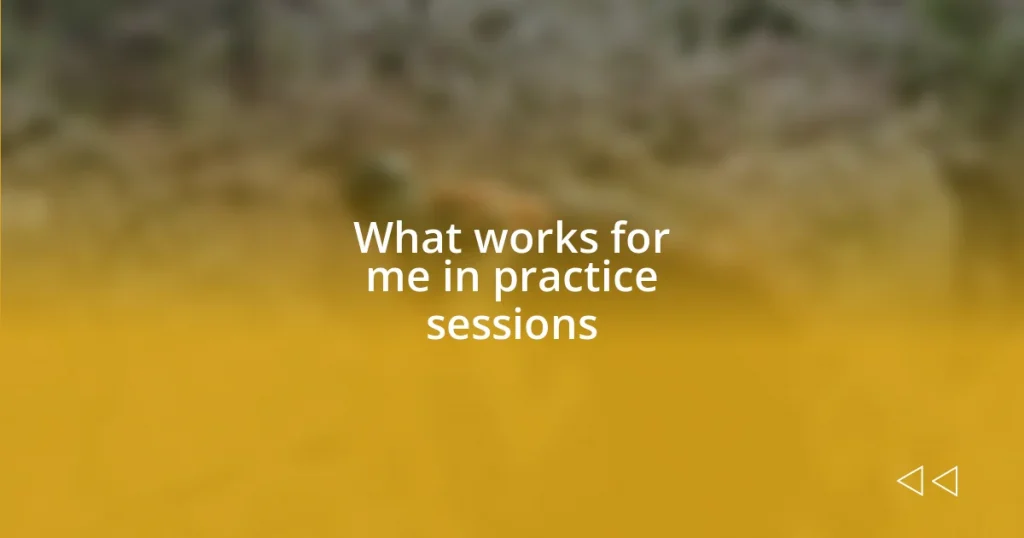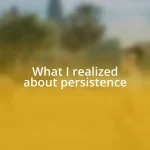Key takeaways:
- Setting clear short-term and long-term practice goals transforms practice sessions into productive experiences and builds a sense of accomplishment.
- Incorporating a variety of practice methods, including themed practice days and exploration, enhances skills and reignites passion for music.
- Regular reflection, self-assessment, and seeking feedback are crucial for evaluating progress and adjusting practice strategies effectively.
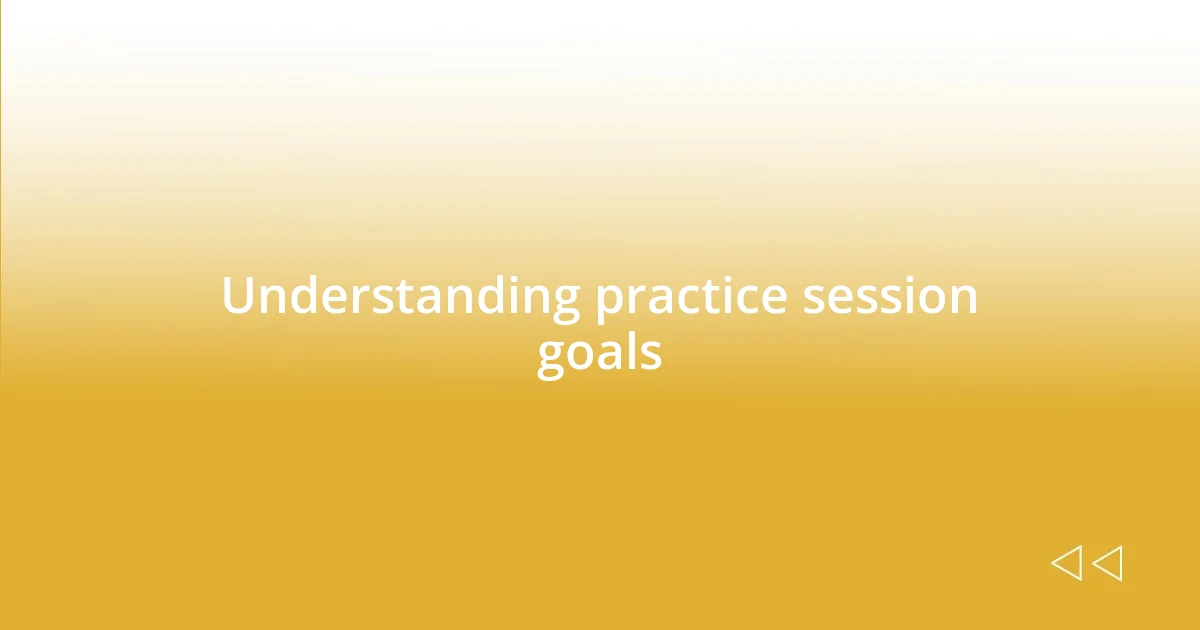
Understanding practice session goals
When I think about practice session goals, I often reflect on how they serve as a roadmap for my growth. Setting clear objectives helps me focus my energy, whether I’m aiming to master a specific technique or enhance my overall performance. Have you ever found yourself wandering aimlessly during a session? It’s frustrating, right? Having defined goals shifts that experience into something much more productive.
In my own practice, I’ve learned the importance of both short-term and long-term goals. For instance, when I was working on a challenging piece, my immediate aim was to perfect a few measures each session. This felt achievable and gave me a sense of accomplishment. Over time, those small victories built up to a significant milestone. What about you? Do you break things down this way, or do you find it more motivating to tackle bigger challenges?
Understanding the emotional aspect of practice goals is equally vital. When I’m connected to why I’m practicing, whether it’s the joy of playing or the excitement of performing, it transforms my sessions. Have you felt that spark when your practice aligns with your passion? It reminds me that goals should resonate with our personal journeys, making the process not just a task, but a celebration of our dedication and love for what we do.
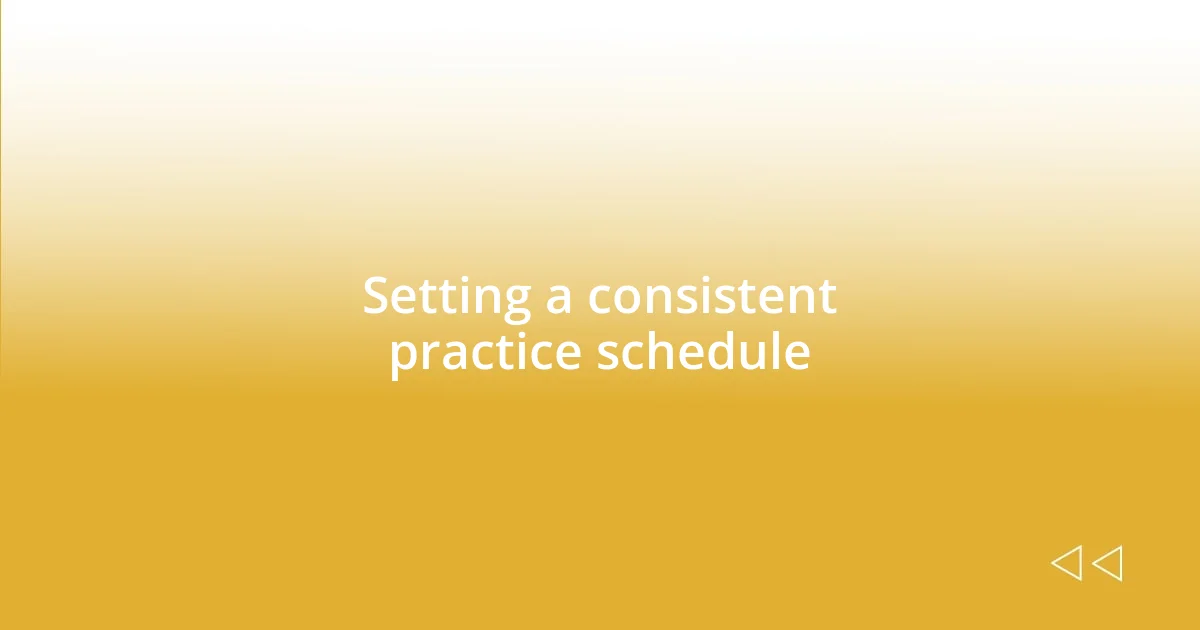
Setting a consistent practice schedule
Establishing a consistent practice schedule has been one of the most transformative choices I’ve ever made. When I committed to specific days and times each week, my practice sessions became less of an obligation and more of a ritual. For me, this structure not only enhanced my skills but also made it easier to anticipate and look forward to these dedicated moments. There’s something comforting about knowing that every Tuesday and Thursday from 5 to 6 PM is reserved for my music. It creates a rhythm in my life that keeps my passion alive.
To set a consistent practice schedule, consider these tips:
- Choose your prime time: Identify when you feel most alert and creative—this is when you’ll get the most out of your practice.
- Stick to it: Treat your practice time like any other important appointment. Write it in your calendar and set reminders.
- Be flexible, but firm: Life happens, so allow yourself some wiggle room, but try to reschedule rather than skip entirely.
- Track your progress: Keep a journal or use a calendar to log your sessions. Seeing your commitment laid out can be incredibly motivating.
- Include an element of joy: End each session with something you love. Whether it’s playing a favorite piece or improvising, make your time something to look forward to.
By incorporating these steps, I’ve transformed my practice sessions into a regular part of my life that fuels my growth and passion.
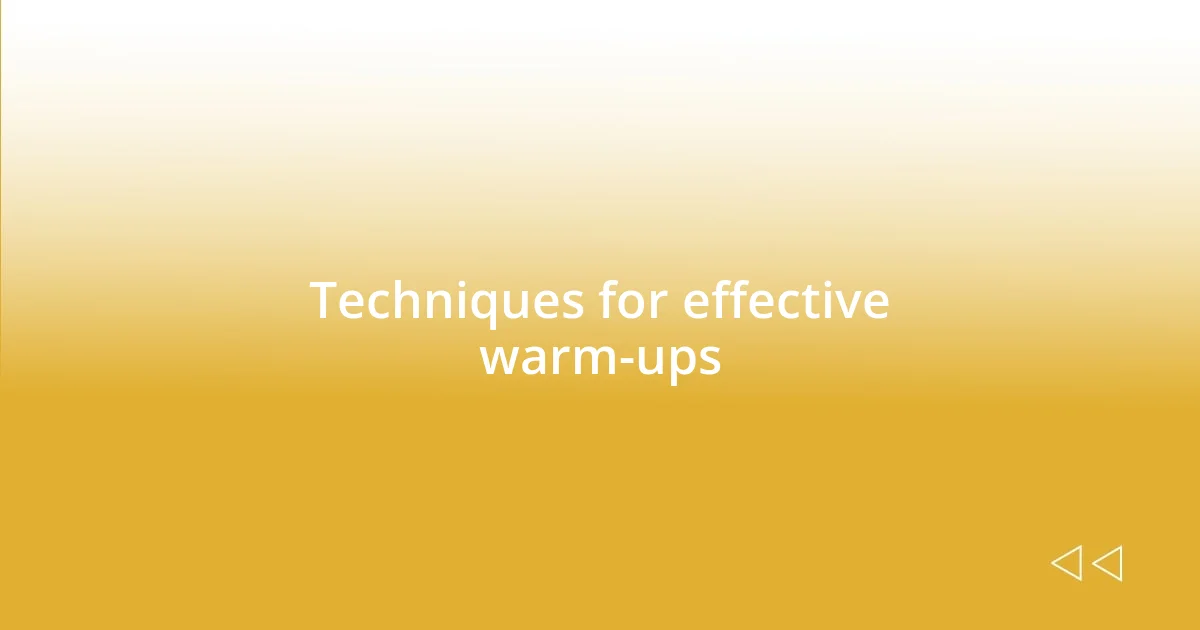
Techniques for effective warm-ups
When it comes to effective warm-ups, I’ve found that starting with engaging and familiar exercises truly sets the tone for the rest of my practice. I often begin with scales or simple arpeggios, as they not only ease me into playing but also help to activate my muscle memory. There’s something comforting about revisiting these fundamentals—they remind me of why I fell in love with music in the first place. Have you ever noticed how a warm-up can shift your mood?
In my experience, incorporating a variety of techniques keeps things interesting. Occasionally, I mix in breathing exercises or quick improvisation to challenge myself. This not only warms up my fingers but gets my creative juices flowing and makes me feel alive. I remember one session where I spontaneously decided to improvise a short melody during my warm-up; it transformed my whole perspective, setting a playful, optimistic tone for that day’s practice. How do you feel when you try something new before diving into the core of your session?
I’ve also discovered that consistency during warm-ups enhances my overall efficiency. On days when I feel sluggish, sticking to my warm-up routine helps ground me. It’s almost like a mental cue to switch gears—an intimate conversation with my instrument. As I engage with these warm-ups, I reflect on this journey and realize I’m not just preparing to practice; I’m nurturing a deeper connection to my craft.
| Warm-up Technique | Benefits |
|---|---|
| Scales and Arpeggios | Enhances muscle memory and technique |
| Breathing Exercises | Improves breath control and relaxation |
| Improvisation | Stimulates creativity and keeps sessions dynamic |
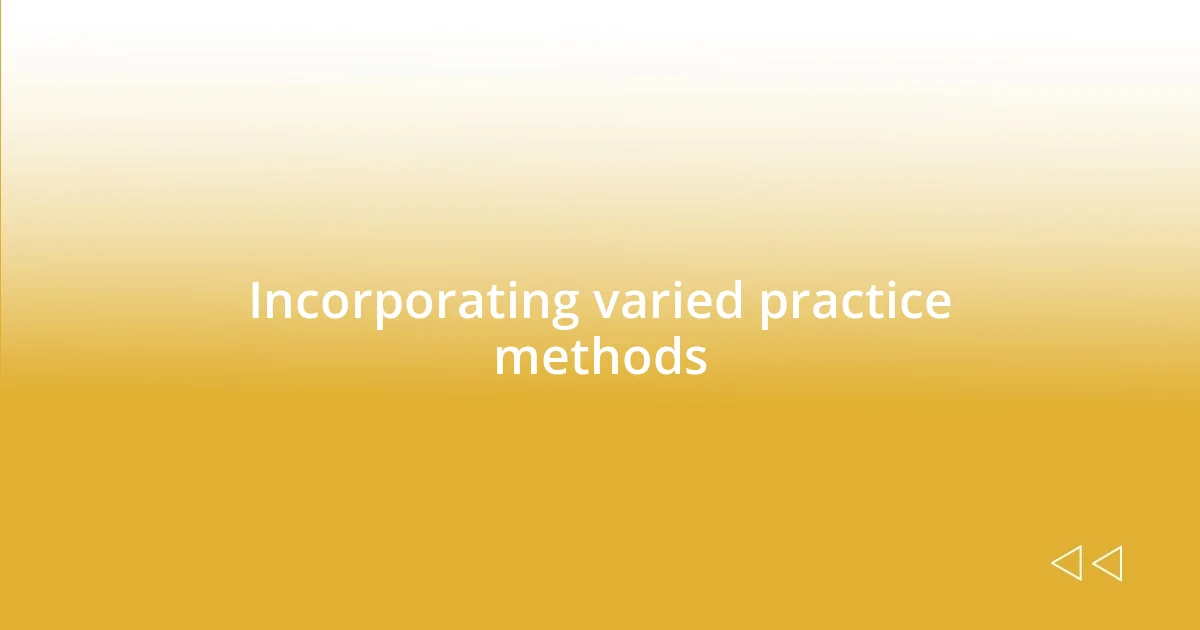
Incorporating varied practice methods
Incorporating varied practice methods has been a game changer for me. I’ve learned that mixing up my techniques not only sharpens my skills, but it also keeps my passion ignited. A few weeks ago, I decided to introduce a themed practice day, focusing solely on jazz improvisation. Initially, it felt daunting, but by stepping out of my comfort zone, I discovered a vibrant world of expression that excited me in ways I hadn’t expected. Have you ever found that shifting your approach can reveal hidden talents?
Exploring different resources is another effective strategy. I often switch between instructional videos, sheet music, and even peer collaborations. For instance, last month, I teamed up with a friend for a duet session where we tackled pieces we both loved but had never attempted together. The fresh energy created a delicious sense of spontaneity and fun that made our hour fly by. Isn’t it fascinating how a new perspective can breathe life into what can sometimes feel like a monotonous routine?
Setting aside time for exploratory practice has also proven beneficial. I remember one practice session where I turned off my metronome and just played—experimenting with dynamics, tempo, and even different styles. This ‘free day’ allowed me to play purely for the joy of it, leading me to invent unique phrases that I later wove into my repertoire. How liberating is it to discover that sometimes, the most profound progress comes when we let go of structure? Embracing this variety has not only enhanced my technical abilities but has enriched my emotional connection to music itself.
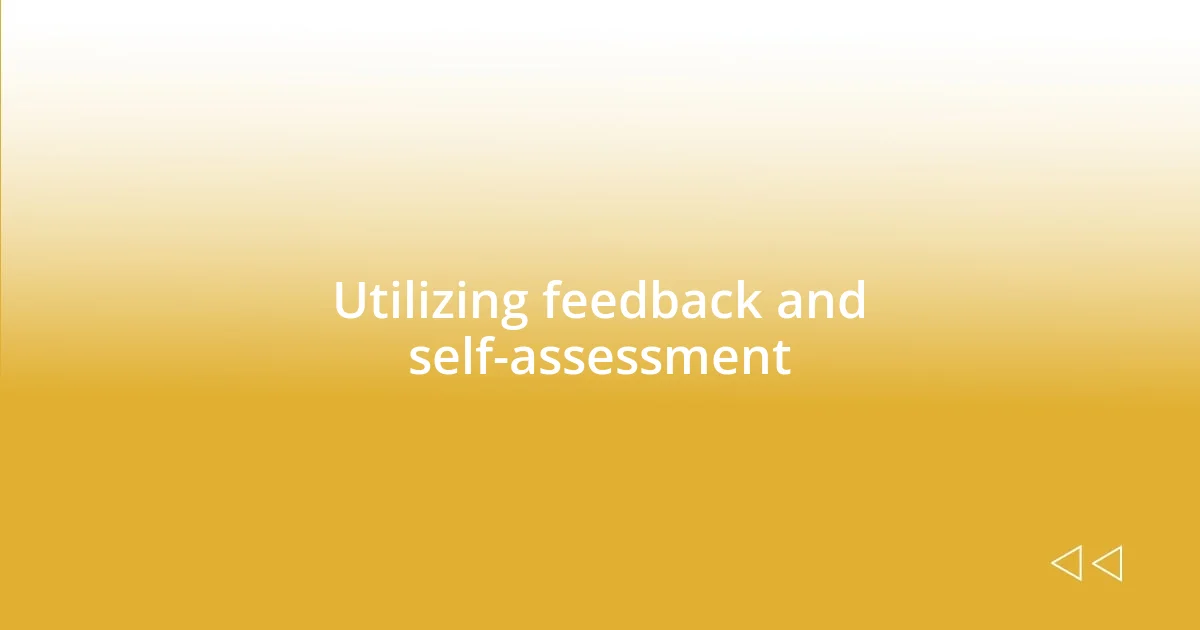
Utilizing feedback and self-assessment
Utilizing feedback and self-assessment is a crucial part of my practice routine. After each session, I take a moment to reflect on what went well and what could be improved. It’s almost like journaling for my musical journey; I jot down insights that strike me, from the nuances of playing a challenging piece to how I felt during improvisation. Have you ever paused to reflect on your practice? I’ve found that this simple act not only heightens my awareness but also gives direction to my future sessions.
Feedback, whether from a mentor or a recording, has also been instrumental in my growth. Recently, I recorded a solo performance and played it back. The experience was enlightening; I noticed subtle hesitations and phrasing issues I had overlooked in the moment. It was humbling but necessary—a reminder of how valuable outside perspectives can be. I often ask myself, “What would I tell a friend struggling with the same issue?” This approach allows me to be kinder to myself while still pushing for improvement.
Self-assessment has transformed over time too. Initially, I relied solely on others’ opinions, but now I trust my judgment more. I’ve developed a checklist highlighting key aspects—tone quality, rhythm accuracy, and emotional delivery—that helps me evaluate my progress objectively. During one practice, after reviewing my checklist, I felt a wave of pride for mastering a tricky transition. Have you ever celebrated a small victory that felt monumental? Those moments fuel my passion and encourage me to keep striving for excellence in my music journey.
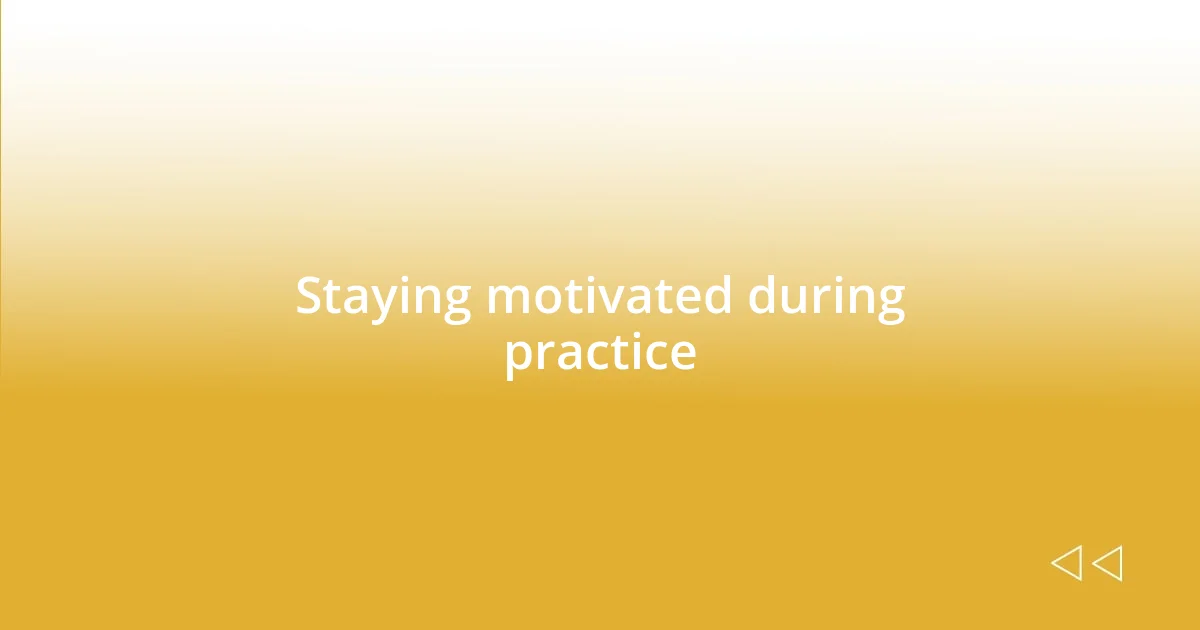
Staying motivated during practice
Staying motivated during practice can sometimes feel like an uphill battle. I remember a period when my enthusiasm waned; practicing began to feel like a chore. To combat this, I started setting achievable goals for each session, focusing on small wins. For example, I aimed to perfect just a couple of measures of a challenging piece. After accomplishing that, the satisfaction became a spark that reignited my drive. Have you ever experienced a moment where a little progress fueled your desire to keep going?
Variety is another key to maintaining my motivation. One day, after a particularly grueling week of structured practice, I decided to throw caution to the wind. I put on my favorite playlist and just jammed along, allowing spontaneity to guide me. That burst of creativity reminded me of why I fell in love with music in the first place. Isn’t it amazing how a simple change can awaken joy and inspiration?
Lastly, surrounding myself with supportive peers has made a significant impact on my motivation. I recall a jam session with friends where we all shared our current challenges—and joys—in practice. Their encouragement was infectious, and playing together added a layer of fun that I hadn’t realized I was missing. Have you ever found a community that lifts you up when you feel down? That connection keeps my spirits high and makes every practice session something I look forward to rather than dread.
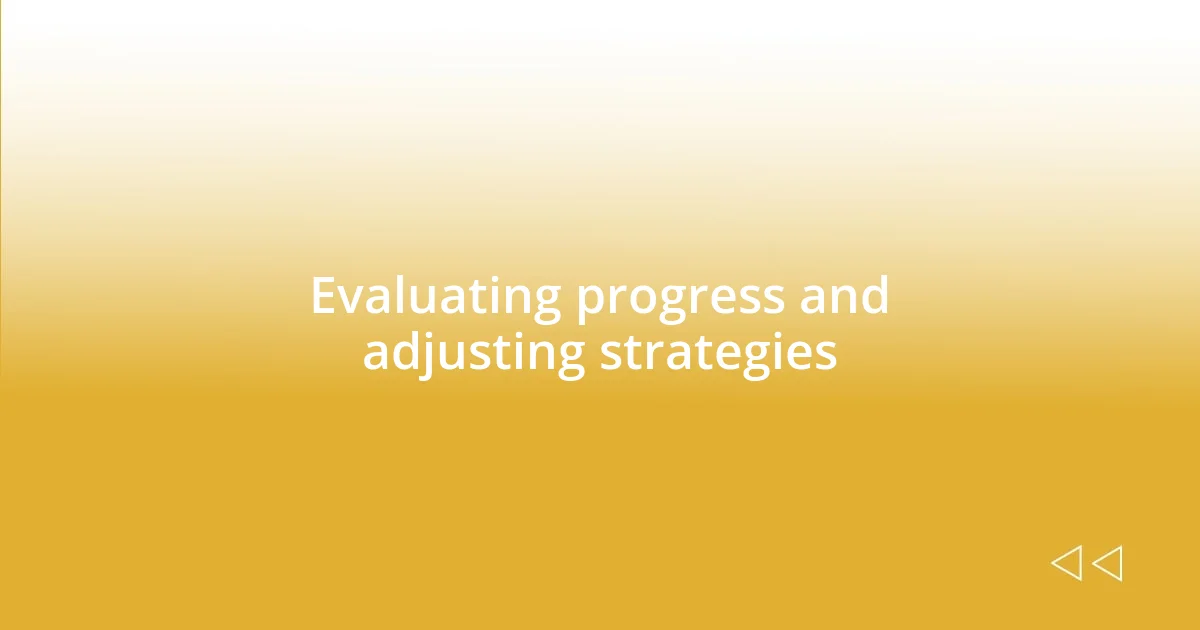
Evaluating progress and adjusting strategies
Evaluating my progress after each practice session is like checking in with a friend. I remember a time when I thought I was progressing well, only to discover I was stuck in my old habits. One day, during a particularly intense review session, I recognized that my finger positioning needed work; it was a revelation that completely reshaped my approach. Have you ever had a moment where the truth hit you like a ton of bricks, prompting a shift in your technique?
Adjusting my strategies based on these evaluations has been an essential part of my learning journey. I once decided to tackle a difficult passage by breaking it down into smaller segments instead of trying to conquer it all at once. This method not only made the piece feel more manageable but also led to noticeable improvements in my confidence. I’ve often wondered: how many times have we hesitated to change our approach simply because we were comfortable? This experience taught me that embracing discomfort opens doors to new possibilities.
Sometimes, I find it valuable to step back and reflect on the bigger picture—how my progress aligns with my long-term goals. During one reflective moment, I realized while my technical skills were improving, the emotional connection to the music was lacking. So, I started incorporating storytelling into my practice sessions. With every note, I ask myself, “What emotion am I trying to convey?” Shifting my focus in this way has not only enhanced my playing but also deepened my enjoyment of each piece. What about you? Have you ever shifted your focus to reignite your passion?










